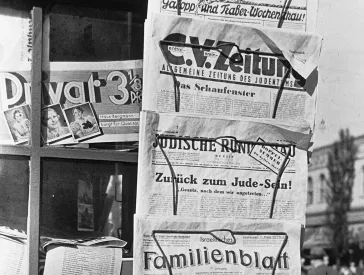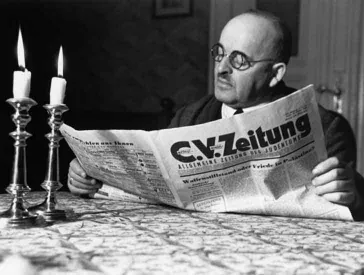Many questions, complex answers: "The Whole Truth … everything you always wanted to know about Jews"
Press Information
Press Release, Wed 20 Mar 2013
How do you know if someone is Jewish? How can you become Jewish yourself? Are Jews good businesspeople? Are you allowed to make jokes about the Holocaust? Do Jews believe in Satan?
Beginning on 22 March, 30 questions such as these will guide visitors through the exhibition "The Whole Truth … everything you always wanted to know about Jews" (22 March to 1 September 2013).
There are questions that visitors would like to see answered by a Jewish museum and ones that adults and school students wish to put to Jews. Over a period of several months, they were chosen from the many questions that repeatedly cropped up in forums and museum guest books and that have been fielded by museum staff.
- Contact
-
Press office
T +49 (0)30 259 93 419
presse@jmberlin.de
- Address
Jewish Museum Berlin Foundation
Lindenstraße 9–14
10969 Berlin
Combining three elements: questions, objects and quotations
Each of the questions is “answered” by an installation that links objects, quotations and texts. Visitors are not given a clear or “correct” answer. Instead, depending on the speaker or context, they are presented with a variety of perspectives. The exhibition features a total of 180 contemporary artworks, religious objects and items from everyday life. They provide insight into Jewish thought, debates among Jews on Jewish identity and the relationship between Jews and their non-Jewish environment.
“Jews in a showcase”
The section devoted to the question “Are there still Jews in Germany?” presents a highly unusual “exhibit.” At set times, a Jewish guest will take his or her seat in a real showcase and, if desired, respond to questions and comments from the visitors. With this idea, the organizers are taking up the gauntlet that critics of Jewish museums have thrown down at the feet of the museums’ founders. The substance of this criticism: Jewish museums could unethically use Jews as “exhibition objects” and subject them to voyeuristic curiosity. Others believe that the Jews in Germany, who have played a prominent role over the past few decades and are seen by many as a symbol of the millions murdered in the Holocaust, are already treated as specimens under glass. After the opening of the Jewish Museum Berlin in 2001, for example, journalist Richard C. Schneider commented on his own position as a Jew saying: “I am a living exhibition object. People … who in their contact with me are encountering a Jew for the first time in their lives, tend to react with confusion. … Suddenly I am seen as in a showcase, as a rare example of a species under glass, which one does not actually know, but thinks one does.” Searching for the “whole truth,” visitors now have the opportunity to confront their confused feelings about Jews.
Unorthodox approaches to provocative questions
In 1951 the first Israeli prime minister, David Ben-Gurion, offered the following ironic definition of "Who is a Jew?": "I consider as Jewish anyone who is meshuge (crazy) enough to call themselves ‘Jewish.’" In the period after Israel was founded, anyone who professed Judaism was regarded as a Jew. Today, however, liberal interpretations stand in strident opposition to orthodox ideas. The compulsive need for scientifically verifiable criteria governing affiliation has now spawned entirely new business models that seek to provide genetic proof of origin and appear to be eliminating the need to undertake difficult efforts to acquire cultural knowledge. A DNA test created for the exhibition by a professional test provider promises to determine and certify a person’s haplogroup, ancestral race, and region of origin. It is billed with the claim that "genetically speaking, Jews are among the most fascinating people in the world."
Whereas many Jewish communities are currently attempting to clarify who they wish to admit into their ranks, non-Jews are often unsure of who they are dealing with. In the room devoted to the question "Jew or not?" visitors stroll past twelve large-format portraits of historical and contemporary figures whose identity (Jewish or not?) remains uncertain to them.
The exhibits linked to the question "Are the Jews a chosen people?" reveal that the concept of chosenness does not necessarily imply Jewish superiority over other people or groups. The presentation of a decorated Torah scroll sets the general tone. Printed on the wall behind it is a verse by Leonard Fein: "How odd of God to choose the Jews. / But how on earth could we refuse?"
Moments of doubtful certainty
Using coins, visitors can vote on whether they think Jews are particularly good businesspeople, intelligent, attractive or fond of animals. The results of this vote are shown at the end of the exhibition.
In addition, the exhibition raises the sensitive question "Are you allowed to make jokes about the Holocaust?" Excerpts from American comedy series show that in the U.S. it is possible to make jokes that only Oliver Polak would dare to tell in Germany. Visitors can decide for themselves whether the humor crosses certain boundaries or whether laughter is permissible.
The quotations and exhibits revolving around the question "Do Germany and Israel have a special relationship?" offer a small cabinet of curiosities relating to German-Israeli relations. For instance, displayed next to a gift presented by the Israeli state to Federal President Joachim Gauck, visitors find the famous Luxembourg Agreement of 1952 with the signatures of foreign ministers Konrad Adenauer and Moshe Sharett. Contrasting with these objects are the exhibits focusing on "master chef" Thomas Franz, who became the best-known German in Israel overnight after winning a cooking competition against an Arab nurse and an orthodox Jewish housewife.
“How can you recognize a Jew?”
An additional installation leads visitors under and along an exhibit of seventy Jewish head coverings. They include a shtreimel, a Borsalino, a miznefet and kippot with a Mercedes star and angry birds. They are orthodox, humorous and commercial, offering special nuances that initiates will immediately recognize. Many Jewish head coverings emerged in response to clothing regulations in specific historical contexts. Today they still can be interpreted as signs of specific religious, ideological and political identifications and affiliations. Other head coverings are discreet symbols of an affiliation that the wearer wishes to demonstrate to the outside world.
“Ask the Rabbi”
A film installation featuring larger than life sized figures provides visitors with fascinating insights into mundane and not-so-mundane questions about Judaism. Seven rabbis in Germany answer a variety of questions about the observance of religious law in everyday life: Can a person be Jewish without being circumcised? Can a Jew ever stop being a Jew? What is the significance of Jesus and Muhammad for Judaism?
Question of the Month
In a witty, easygoing and provocative manner, the exhibition "The Whole Truth … everything you always wanted to know about Jews" addresses many current social issues, poses counter-questions and makes visitors aware of stereotypical perceptions and patterns of thought. In the epilogue to the exhibition, visitors are asked to post their questions and comments on a wall for the next group to respond to, comment on and analyze. By September, a "question of the month" will be selected from these comments and addressed in a video blog.
The exhibition at the Jewish Museum Berlin has been organized in cooperation with the Jewish Museum Hohenems. It has been generously supported by the Deutsche Klassenlotterie Berlin.
Media partners:
Wall AG, zittyBerlin, Yorck Kinogruppe, Dussmann das KulturKaufhaus



